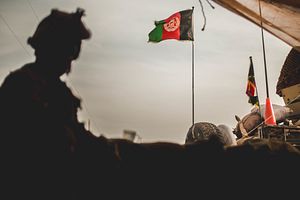By Catherine Putz
 In recent days, both U.S. special envoy Zalmay Khalilzad and Secretary of State Mike Pompeo have made comments that, at the very least, appear to temper expectations for an Afghan peace deal after weeks of unfulfilled rumors that a ceasefire was looming. This comes as recent report found that violence is at a high in Afghanistan despite the ongoing negotiations. Meanwhile, Afghanistan’s September presidential election results remain unfinalized and its top leaders at odds.
In recent days, both U.S. special envoy Zalmay Khalilzad and Secretary of State Mike Pompeo have made comments that, at the very least, appear to temper expectations for an Afghan peace deal after weeks of unfulfilled rumors that a ceasefire was looming. This comes as recent report found that violence is at a high in Afghanistan despite the ongoing negotiations. Meanwhile, Afghanistan’s September presidential election results remain unfinalized and its top leaders at odds.
On Saturday, Khalilzad arrived in Kabul after various meetings in Doha, Brussels, and Islamabad. He met, separately, with President Ashraf Ghani and Chief Executive Abdullah Abdullah.
The two Afghan leaders remain in contention over the results of last September’s presidential election. Preliminary results, announced in December, pegged Ghani as the winner by a tiny margin (50.6 percent). Khaama Press reported this week that the Independent Election Complaints Commission (IECC) had announced it would put out official results within the week. From Khaama Press:
Informed sources and experts believe the election will have no winner in the first round as the final results are announced.
A source who did not want to be named in the report told Khaama Press that the election will have no winner and the continuation of the National Unity Government (NUG) is a priority now.
If no candidate takes more than 50 percent of the vote, a second round of voting will take place.
The National Unity Government, established between Ghani and Abdullah in 2014 with no small amount of nudging from Washington in the form of then-Secretary of State John Kerry, has rarely appeared unified in the years since. Among other areas of disagreement, Ghani and Abdullah have been unable to agree on a negotiating team to face the Taliban. Abdallah has also accused Ghani of foiling efforts at peace by imposing new conditions on talks.
While Kabul grapples with its internal politics, the United States has continued negotiations with the Taliban. The outline of a peace deal is well known, with the main contours including a ceasefire, a withdrawal of U.S. troops, the start of intra-Afghan negotiations, and a pledge by the Taliban to not allow Afghan soil be used to stage attacks against the United States.
In late December, various media began reporting that a ceasefire was imminent, but so far nothing close has occurred. As the Washington Post reported on January 1:
“The Islamic Emirate has no intention of declaring a cease-fire,” Zabiullah Mujahid, the main Taliban spokesman, said in a statement, using the group’s name for a religious government. “The United States has asked for a reduction in the scale and intensity of violence, and discussions being held by the Islamic Emirate are revolving solely around this specific issue.”
American officials have said nothing about the conflicting reports; even the main U.S. negotiator, Zalmay Khalilzad, usually a fount of upbeat tweets, has fallen silent since returning to Washington this week after meeting with Taliban and Pakistani officials.
With that background, according to Ghani’s office, in the president’s meeting with Khalilzad on February 1, the U.S. envoy said, “We are waiting for a clear response from the Taliban about a ceasefire or a significant and lasting reduction in violence based on a practical mechanism which is acceptable to the people of Afghanistan and the U.S. government.”
Furthermore, the readout claimed that Khalilzad said there had been no significant progress in talks with the Taliban.
On Monday, U.S. Secretary of State Mike Pompeo said in a press conference in the capital of neighboring Uzbekistan that “We got close once before to having an agreement: a piece of paper that we mutually executed and the Taliban were unable to demonstrate either their will or capacity or both to deliver on a reduction in violence.”
“So, what we are demanding now is demonstrable evidence of their will and capacity to reduce violence, to take down the threat, so the inter-Afghan talks … will have a less violent context,” he said. “We’re hopeful we can achieve that but we’re not there yet, and work certainly remains.”
These comments from Khalilzad and Pompeo, in turn, come just after the Special Inspector General for Afghanistan Reconstruction (SIGAR) released its 46th quarterly report, which highlighted record levels of violence despite the last year of shuttle diplomacy for Khalilzad in search of a peace deal.
So where does this leave the process? The American side, per the above statements, is at present pushing the message that a reduction of violence is needed first, before the next steps can take place. The Taliban, per the January 1 statement, is having its own internal debate on that subject.
The concept of “negotiating from a position of strength” has been espoused by both sides at various points in time. Reaching a deal is arguably difficult under such conditions since both sides cannot objectively have the upper hand at the same time.
With reporting from the Associated Press.
No comments:
Post a Comment